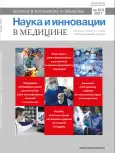Междисциплинарный подход в сурдологии – опыт слухопротезирования детей с нарушением слуха
- Авторы: Туфатулин Г.Ш.1,2, Королёва И.В.1,3, Коркунова М.С.1
-
Учреждения:
- СПб ГКУЗ «Детский городской сурдологический центр»
- ГБОУ ВО «Северо-Западный государственный медицинский университет им. И.И. Мечникова» Минздрава России
- ФГБУ «Санкт-Петербургский НИИ уха, горла, носа и речи» Минздрава России
- Выпуск: Том 6, № 1 (2021)
- Страницы: 20-24
- Раздел: Болезни уха, горла и носа
- URL: https://journal-vniispk.ru/2500-1388/article/view/59051
- DOI: https://doi.org/10.35693/2500-1388-2021-6-1-20-24
- ID: 59051
Цитировать
Полный текст
Аннотация
Цель – разработка алгоритма междисциплинарного взаимодействия врача-сурдолога-протезиста и сурдопедагога при первичном слухопротезировании детей с нарушениями слуха.
Материал и методы. 219 детей в возрасте от 2 месяцев до 16 лет с нарушениями слуха были разделены на 2 группы. Экспериментальную группу составили дети, проходившие специальный курс медико-психолого-педагогической реабилитации на этапе первичного слухопротезирования, основанный на оригинальном алгоритме междисциплинарного взаимодействия врача-сурдолога-протезиста и сурдопедагога. Контрольная группа включала детей, слухопротезированных по традиционной схеме, в которой врач-сурдолог не взаимодействовал с сурдопедагогом в процессе слухопротезирования ребенка.
Результаты. При разработке алгоритма взаимодействия врача-сурдолога-протезиста и сурдопедагога были выделены 3 этапа слухопротезирования (подготовительный, этап первичной настройки слуховых аппаратов, этап адаптации и уточняющей настройки). Определены задачи каждого специалиста на этих этапах, в том числе включение родителей в процесс слухопротезирования ребенка. Разработан протокол обмена информацией между специалистами. Алгоритм был реализован в специальном курсе медико-психолого-педагогической реабилитации в городском детском сурдоцентре.
Установлено, что через 1 месяц после первичной настройки среди детей, прошедших этот курс, достоверно большее число детей использовали слуховые аппараты более 8 часов в сутки и достигли интегрального критерия эффективного слухопротезирования по сравнению с контрольной группой. Для коррекции параметров настройки слуховых аппаратов при повторных настроечных сессиях у этих детей также требовалось меньше времени.
Заключение. Структурированное междисциплинарное взаимодействие врача-сурдолога-протезиста и сурдопедагога на этапе первичного слухопротезирования значительно повышает эффективность медицинской технологии восстановления слуховой функции у детей.
Ключевые слова
Полный текст
Открыть статью на сайте журналаОб авторах
Г. Ш. Туфатулин
СПб ГКУЗ «Детский городской сурдологический центр»; ГБОУ ВО «Северо-Западный государственный медицинский университет им. И.И. Мечникова» Минздрава России
Автор, ответственный за переписку.
Email: dr.tufatulin@mail.ru
ORCID iD: 0000-0002-6809-7764
к.м.н., главный врач, ассистент кафедры оториноларингологии
Россия, Санкт-ПетербургИ. В. Королёва
СПб ГКУЗ «Детский городской сурдологический центр»; ФГБУ «Санкт-Петербургский НИИ уха, горла, носа и речи» Минздрава России
Email: prof.inna.koroleva@mail.ru
ORCID iD: 0000-0001-8909-4602
д.психол.н., профессор, главный научный сотрудник, научный руководитель программ реабилитации
Россия, Санкт-ПетербургМ. С. Коркунова
СПб ГКУЗ «Детский городской сурдологический центр»
Email: korkynova@yandex.ru
учитель-сурдопедагог
Россия, Санкт-ПетербургСписок литературы
- Fernandez R, Grand JA. Leveraging social science-healthcare collaborations to improve teamwork and patient safety. Pediatric and Adolescent Health Care. 2015;45:370–377. doi: 10.1016/cppeds.2015.10.005
- Rosen MA, Diaz Granados D, Dietz AS, Benishek LE, Thompson D, Pronovost PJ, Weaver SJ. Teamwork in Healthcare: Key Discoveries Enabling Safer, High-Quality Care. Am Psychol. 2018;73(4):433–450. doi: 10.1037/amp0000298
- Chernyavskiy MA, Gusev AA, Dalmatova AB, et al. Organization of multidisciplinar approach in treatment of patients with diabetic foot syndrome. Translational Medicine. 2018;5(1):5–14. (In Russ.). [Чернявский М.А., Гусев А.А., Далматова А.Б. и др. Организация командного подхода в лечении пациентов с синдромом диабетической стопы. Трансляционная медицина. 2018;5(1):5–14]. doi.org/10.18705/2311-4495-2018-5-1-5-14
- Chumak EG, Pikinskaya MV, Vozmilova OV eds. Early intervention technology as a comprehensive support for children with disabilities. Surgut, 2014. (In Russ.). [Чумак Е.Г., Пикинская М.В., Возмилова О.В. Технология раннего вмешательства как комплексное сопровождение детей с ограниченными возможностями здоровья. Сургут, 2014].
- Koroleva IV. Educational activities for children with early hearing impairment. SPb.: KARO; 2017. (In Russ.). [Королева И.В. Развивающие занятия с детьми с нарушением слуха раннего возраста. СПб.: КАРО; 2017].
- Tavartkiladze GA. Handbook on clinical audiology. M.: Meditsina; 2013. (In Russ.). [Таварткиладзе Г.А. Руководство по клинической аудиологии. М.: Медицина; 2013].
- McCreery RW, Walker EA. Pediatric Amplification: Enhancing Auditory Access. San Diego: Plural Publishing; 2017.
- Garbaruk ES, Koroleva IV. Amplification diary for an early age child. SPb, 2015. (In Russ.). [Гарбарук Е.С., Королева И.В. Дневник слухопротезирования ребенка раннего возраста. СПб., 2015].
- Tufatulin GSh, Koroleva IV, Yanov YuK, et al. Hydrovibrotactile stimulation of deaf children. Russian Otorhinolaryngology. 2020;19(5):83–91. (In Russ.). [Туфатулин Г.Ш., Королева И.В., Янов Ю.К., Артюшкин С.А., Черняховский А.Е. Гидровибрационная стимуляция в реабилитации детей с тугоухостью высокой степени. Российская оториноларингология. 2020;19(5):83–91]. doi.org/10.18692/1810-4800-2020-5-83-91
Дополнительные файлы









